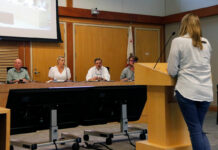Power washing and our local creeks
Spring is coming and it will be time to clean up around our home and yard. An increasingly popular way to clean the house, deck, driveway, patio, and equipment is to use a power washer. You can buy or rent a power washer, or even hire a contractor.
What’s the problem with power or pressure washing?
Power washing itself is not a problem. If done correctly, it can actually help keep pollution out of our local waterways. The problem is there is a lot besides water in the runoff from power or pressure washing. If the wastewater is not collected properly, all of this pollution will flow into a storm drain. Water entering a storm drain is not treated or cleaned before entering our creeks and rivers. Clean water is important for the environment and the economy. It provides a chance for recreational activities like swimming, fishing, hiking and boating. Clean drinking water is vital for public health and the Russian River provides drinking water for a significant portion of the watershed.
Where do these pollutants come from?
In general, three parts of the cleaning process can cause problems for the environment:
• Using harmful cleaning chemicals—including soaps as well as solvents (even biodegradable soaps contain ingredients which are initially toxic to fish and other aquatic life);
• Removing toxic materials such as oil, antifreeze, grease, fuels, and heavy metals from driveways, sidewalks, other surfaces, and equipment; and
• Generating other waste such as paint chips (paint produced before 1972 contains lead), sediment, pet waste (bacteria problem), litter, chlorine, and pesticides.
So where should waste water go?
The first choice is to collect and dispose the wash water to the sanitary sewer through a sink, toilet or sewer clean out. This will ensure the wash water will be sent to the wastewater treatment plant for treatment and reuse. If hazardous materials (petroleum products, fuels, antifreeze, solvents, and pesticides) are involved, the water will need to be disposed of as hazardous waste and cannot be discharged to the sanitary sewer.
To avoid the hazardous waste problem and reduce the amount of wastewater that needs special handling, you need to properly pre-clean the area you will be pressure washing. Pre-cleaning includes removing litter, dirt, and other debris. Use rags or an absorbent material like kitty litter to remove any oil, grease, or other petroleum products. Collect the rags and absorbent material and dispose of them at a Household Toxics Facility. Now the waste water may not need to be treated as hazardous waste.
How is the water collected for disposal?
Collect water for disposal by creating a barrier with sand bags or seal the storm drain openings with plugs or rubber mats. Wastewater can be collected from its containment using a wet vacuum, a sump pump, or a vacuum pump. It is important to collect your wastewater because any pollutants left on the pavement will eventually be carried into a nearby storm drain by rainwater. A hose can direct the waste water to a sanitary sewer clean-out or a sink. It is unsafe and illegal to use or open a sanitary sewer manhole for any reason.
Discharging power washing waste water to a landscaped area may be allowed if there are no hazardous materials involved and no soaps are used. Pre-cleaning and blocking the storm drain is always required. When routing wash water to landscaping, check the slope and area to be sure you will avoid runoff into a street or gutter. If the soil is very dry, wet it down thoroughly before discharging so that wash water will soak into the soil instead of running off to the street, gutter, or storm drain. The planted area must be able to absorb all the water you divert to it.
Discharging waste water to the storm drain may be allowed for sidewalks and residential buildings where there isn’t sufficient landscaping. However, no soaps are to be used, the area must be pre-cleaned (no hazardous materials are present), and no paint is to be removed. In addition, a filter will need to be used at the storm drain inlet using a screen over the inlet or a gravel bag of filter fabric around the inlet.
For more information on where to dispose of hazardous waste in Sonoma County: call the EcoDesk (707-565-DESK) for a list of approved hazardous waste recyclers and disposal sites, or visit www.recyclenow.org.
This article was authored by Forest L. Frasieur of the City of Santa Rosa Utilities Department on behalf of RRWA. RRWA (www.rrwatershed.org) is an association of local public agencies in the Russian River Watershed that have come together to coordinate regional programs for clean water, fisheries restoration, and watershed enhancement.








